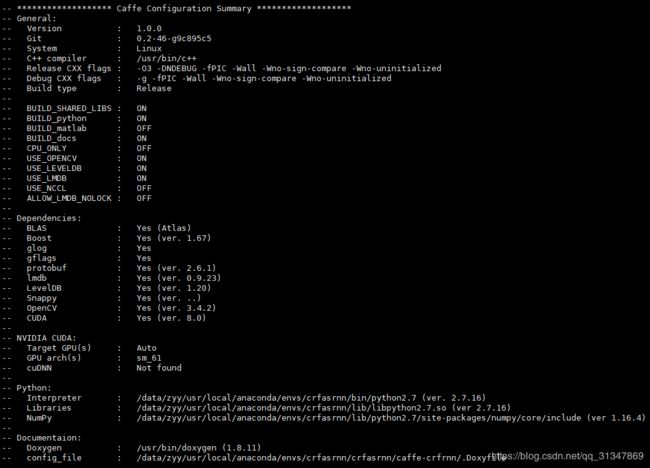Anaconda沙盒+Caffe编译安装 v2
环境说明:
Ubuntu 16.04
CUDA = 9.0
CUDNN = 7.5.1
python = 2.7
protobuf = 2.6.1
gcc = 5.4.0
g++ = 5.4.0
安装步骤
1. 创建虚拟环境并安装依赖
用 conda 创建一个虚拟环境 caffe27(名字随意,这里用27的意思是python版本是2.7的意思),激活该环境,并进入该环境目录下 clone 一下 caffe 的源文件:
# 创建虚拟环境
conda create -n caffe27 python=2.7
# 激活环境
conda activate caffe27
# 进入环境目录下
cd anaconda/envs/caffe27/
# 下载caffe文件
git clone https://github.com/BVLC/caffe.git
安装系统级的依赖:
sudo apt-get install libprotobuf-dev libleveldb-dev libsnappy-dev libopencv-dev libhdf5-serial-dev protobuf-compiler
sudo apt-get install --no-install-recommends libboost-all-dev
在沙盒caffe27内安装依赖:
# 可以直接安装所有需要的包
conda install caffe-gpu
# 这里下载的protobuf是3.7版本,为了不和后面要使用的2.6.1版本冲突,先卸载掉
conda uninstall protobuf
conda uninstall libprotobuf
# 这里自动安装了cudnn7.3.1,但是我们需要的是cudnn7.5.1且已经安装好了,所以卸载掉
conda uninstall cudnn
2. 修改配置文件
修改配置文件Makefile.config:
## Refer to http://caffe.berkeleyvision.org/installation.html
# Contributions simplifying and improving our build system are welcome!
# cuDNN acceleration switch (uncomment to build with cuDNN).
USE_CUDNN := 1
# CPU-only switch (uncomment to build without GPU support).
# CPU_ONLY := 1
# uncomment to disable IO dependencies and corresponding data layers
USE_OPENCV := 1
USE_LEVELDB := 1
USE_LMDB := 1
# This code is taken from https://github.com/sh1r0/caffe-android-lib
# USE_HDF5 := 0
# uncomment to allow MDB_NOLOCK when reading LMDB files (only if necessary)
# You should not set this flag if you will be reading LMDBs with any
# possibility of simultaneous read and write
# ALLOW_LMDB_NOLOCK := 1
# Uncomment if you're using OpenCV 3
# OPENCV_VERSION := 3
# To customize your choice of compiler, uncomment and set the following.
# N.B. the default for Linux is g++ and the default for OSX is clang++
# CUSTOM_CXX := g++
# CUDA directory contains bin/ and lib/ directories that we need.
CUDA_DIR := /data/zyy/usr/local/cuda-9.0
# On Ubuntu 14.04, if cuda tools are installed via
# "sudo apt-get install nvidia-cuda-toolkit" then use this instead:
# CUDA_DIR := /usr
# CUDA architecture setting: going with all of them.
# For CUDA < 6.0, comment the *_50 through *_61 lines for compatibility.
# For CUDA < 8.0, comment the *_60 and *_61 lines for compatibility.
# For CUDA >= 9.0, comment the *_20 and *_21 lines for compatibility.
CUDA_ARCH := -gencode arch=compute_30,code=sm_30 \
-gencode arch=compute_35,code=sm_35 \
-gencode arch=compute_50,code=sm_50 \
-gencode arch=compute_52,code=sm_52 \
-gencode arch=compute_60,code=sm_60 \
-gencode arch=compute_61,code=sm_61 \
-gencode arch=compute_61,code=compute_61
# BLAS choice:
# atlas for ATLAS (default)
# mkl for MKL
# open for OpenBlas
BLAS := atlas
# Custom (MKL/ATLAS/OpenBLAS) include and lib directories.
# Leave commented to accept the defaults for your choice of BLAS
# (which should work)!
# BLAS_INCLUDE := /path/to/your/blas
# BLAS_LIB := /path/to/your/blas
# Homebrew puts openblas in a directory that is not on the standard search path
# BLAS_INCLUDE := $(shell brew --prefix openblas)/include
# BLAS_LIB := $(shell brew --prefix openblas)/lib
# This is required only if you will compile the matlab interface.
# MATLAB directory should contain the mex binary in /bin.
# MATLAB_DIR := /usr/local
# MATLAB_DIR := /Applications/MATLAB_R2012b.app
# NOTE: this is required only if you will compile the python interface.
# We need to be able to find Python.h and numpy/arrayobject.h.
# PYTHON_INCLUDE := /usr/include/python2.7 \
/usr/lib/python2.7/dist-packages/numpy/core/include
# Anaconda Python distribution is quite popular. Include path:
# Verify anaconda location, sometimes it's in root.
ANACONDA_HOME := $(HOME)/anaconda/envs/caffe27
PYTHON_INCLUDE := $(ANACONDA_HOME)/include \
$(ANACONDA_HOME)/include/python2.7 \
$(ANACONDA_HOME)/lib/python2.7/site-packages/numpy/core/include
# Uncomment to use Python 3 (default is Python 2)
# PYTHON_LIBRARIES := boost_python3 python3.5m
# PYTHON_INCLUDE := /usr/include/python3.5m \
# /usr/lib/python3.5/dist-packages/numpy/core/include
# We need to be able to find libpythonX.X.so or .dylib.
# PYTHON_LIB := /usr/lib
PYTHON_LIB := $(ANACONDA_HOME)/lib
# Homebrew installs numpy in a non standard path (keg only)
# PYTHON_INCLUDE += $(dir $(shell python -c 'import numpy.core; print(numpy.core.__file__)'))/include
# PYTHON_LIB += $(shell brew --prefix numpy)/lib
# Uncomment to support layers written in Python (will link against Python libs)
WITH_PYTHON_LAYER := 1
# Whatever else you find you need goes here.
INCLUDE_DIRS := $(PYTHON_INCLUDE) $(ANACONDA_HOME)/include /usr/local/include /usr/include/hdf5/serial/
LIBRARY_DIRS := $(PYTHON_LIB) $(ANACONDA_HOME)/lib /usr/local/lib /usr/lib /usr/lib/x86_64-linux-gnu/hdf5/serial
# If Homebrew is installed at a non standard location (for example your home directory) and you use it for general dependencies
# INCLUDE_DIRS += $(shell brew --prefix)/include
# LIBRARY_DIRS += $(shell brew --prefix)/lib
# NCCL acceleration switch (uncomment to build with NCCL)
# https://github.com/NVIDIA/nccl (last tested version: v1.2.3-1+cuda8.0)
# USE_NCCL := 1
# Uncomment to use `pkg-config` to specify OpenCV library paths.
# (Usually not necessary -- OpenCV libraries are normally installed in one of the above $LIBRARY_DIRS.)
# USE_PKG_CONFIG := 1
# N.B. both build and distribute dirs are cleared on `make clean`
BUILD_DIR := build
DISTRIBUTE_DIR := distribute
# Uncomment for debugging. Does not work on OSX due to https://github.com/BVLC/caffe/issues/171
# DEBUG := 1
# The ID of the GPU that 'make runtest' will use to run unit tests.
TEST_GPUID := 0
# enable pretty build (comment to see full commands)
Q ?= @
CXXFLAGS+=-std=c++11
CUSTOM_CXX := g++ -std=c++11
具体这些怎么改参考另一篇:Ubuntu 16.04下Caffe的配置过程
3. 编译caffe
# 在caffe根目录下
mkdir build
cd build
cmake -D CMAKE_BUILD_TYPE=Release -D BLAS=Open -D BUILD_SHARED_LIBS=Off ..
特别关注一下 cmake 显示的 protobuf 版本信息,查看当前使用的 protobuf 的版本:
whereis protoc
which protoc
protoc --version
cmake 输出的配置信息,关注一下版本都是否正确:


继续编译:(可能会有warning,但没有error就行)
make all -j8
make install -j8
make runtest -j8
make all -j8 输出:

make install -j8 输出:

runtest 最后输出:

最后注意环境变量里要在PYTHONPATH中添加caffe/python的路径,并更新环境变量:(注意是caffe工程根目录下的python!)
export PYTHONPATH="/data/zyy/usr/local/anaconda/envs/caffe27/caffe/python"
# 更新环境变量
source ~/.bashrc
# 重新进入虚拟环境
conda activate caffe27
再编译 python 用到的 caffe 文件,否则 python 无法 import caffe:
make pycaffe -j8
4. 验证caffe
验证一下 caffe 是否安装成功,只要 import 没有报错就行。
conda activate caffe27
python
import caffe
# 查看caffe版本
print caffe.__version__
安装问题记录
2019/7/4 8:38更新
(1)camke … 时出现 "cuDNN not found"
在第一步 cmake .. 时会打印 Caffe 配置信息,仔细查看 NVIDIA CUDA 下的 cuDNN 信息,出现下面的情况 Not found,为什么找不到具体原因不明。
解决方案:在 cmake 时手动指定一下 cuDNN 的路径(下面无视我的 cuda 版本,这是另一个 cuda 环境,和上文配置无关)
# 注意分别是cuDNN解压出来的include和lib64,不是cuda下面的
cmake -DCUDNN_INCLUDE="/data/zyy/usr/local/cuda/cuda8.0/cuda/include" -DCUDNN_LIBRARY="/data/zyy/usr/local/cuda/cuda8.0/cuda/lib64/libcudnn.so"

